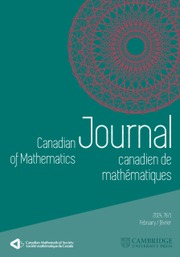Crossref Citations
This article has been cited by the following publications. This list is generated based on data provided by
Crossref.
Crann, Jason
and
Tanko, Zsolt
2017.
On the operator homology of the Fourier algebra and its cb-multiplier completion.
Journal of Functional Analysis,
Vol. 273,
Issue. 7,
p.
2521.
Skalski, Adam
and
Viselter, Ami
2019.
Convolution semigroups on locally compact quantum groups and noncommutative Dirichlet forms.
Journal de Mathématiques Pures et Appliquées,
Vol. 124,
Issue. ,
p.
59.
Bearden, Alex
and
Crann, Jason
2021.
A weak expectation property for operator modules, injectivity and amenable actions.
International Journal of Mathematics,
Vol. 32,
Issue. 02,
p.
2150005.
Crann, Jason
2021.
Finite presentation, the local lifting property, and local approximation properties of operator modules.
Journal of Functional Analysis,
Vol. 281,
Issue. 6,
p.
109070.
McKee, Andrew
and
Pourshahami, Reyhaneh
2022.
Amenable and inner amenable actions and approximation properties for crossed products by locally compact groups.
Canadian Mathematical Bulletin,
Vol. 65,
Issue. 2,
p.
381.
Crann, Jason
and
Neufang, Matthias
2022.
A Non-commutative Fejér Theorem for Crossed Products, the Approximation Property, and Applications.
International Mathematics Research Notices,
Vol. 2022,
Issue. 5,
p.
3571.
Anderson-Sackaney, Benjamin
2022.
On ideals of L1-algebras of compact quantum groups.
International Journal of Mathematics,
Vol. 33,
Issue. 12,
Mathieu, Martin
and
Rosbotham, Michael
2023.
Exact structures for operator modules.
Canadian Journal of Mathematics,
Vol. 75,
Issue. 2,
p.
421.
Soltani Renani, S.
and
Yari, Z.
2023.
Projectivity of Some Banach Right Modules over the Group Algebra ℓ1(G).
Analysis Mathematica,
Vol. 49,
Issue. 3,
p.
881.
Soltani Renani, S.
and
Yari, Z.
2024.
Character Contractibility and Amenability of Banach Algebras with Applications to Quantum Groups.
Siberian Mathematical Journal,
Vol. 65,
Issue. 2,
p.
448.
Buss, Alcides
Echterhoff, Siegfried
and
Willett, Rufus
2024.
Amenability and Weak Containment for Actions of Locally Compact Groups on 𝐶*-Algebras.
Memoirs of the American Mathematical Society,
Vol. 301,
Issue. 1513,
Daws, Matthew
Krajczok, Jacek
and
Voigt, Christian
2024.
The approximation property for locally compact quantum groups.
Advances in Mathematics,
Vol. 438,
Issue. ,
p.
109452.
Anderson-Sackaney, Benjamin
and
Khosravi, Fatemeh
2024.
Topological boundaries of representations and coideals.
Advances in Mathematics,
Vol. 452,
Issue. ,
p.
109830.
De Ro, Joeri
and
Hataishi, Lucas
2024.
Actions of Compact and Discrete Quantum Groups on Operator Systems.
International Mathematics Research Notices,
Vol. 2024,
Issue. 15,
p.
11190.
De Ro, Joeri
2025.
Morita Theory for Dynamical von Neumann Algebras.
International Mathematics Research Notices,
Vol. 2025,
Issue. 12,
 $\mathbb{G}$ and 1-injectivity of
$\mathbb{G}$ and 1-injectivity of  ${{L}^{\infty }}\left( \widehat{\mathbb{G}} \right)$ as an operator
${{L}^{\infty }}\left( \widehat{\mathbb{G}} \right)$ as an operator  ${{L}^{1}}\left( \widehat{\mathbb{G}} \right)$ -module. In particular, a locally compact group
${{L}^{1}}\left( \widehat{\mathbb{G}} \right)$ -module. In particular, a locally compact group  $G$ is amenable if and only if its group von Neumann algebra
$G$ is amenable if and only if its group von Neumann algebra  $\text{VN}\left( G \right)$ is 1-injective as an operator module over the Fourier algebra
$\text{VN}\left( G \right)$ is 1-injective as an operator module over the Fourier algebra  $A\left( G \right)$ . As an application, we provide a decomposability result for completely bounded
$A\left( G \right)$ . As an application, we provide a decomposability result for completely bounded  ${{L}^{1}}\left( \widehat{\mathbb{G}} \right)$ -module maps on
${{L}^{1}}\left( \widehat{\mathbb{G}} \right)$ -module maps on  ${{L}^{\infty }}\left( \widehat{\mathbb{G}} \right)$ , and give a simplified proof that amenable discrete quantum groups have co-amenable compact duals, which avoids the use of modular theory and the Powers-Størmer inequality, suggesting that our homological techniques may yield a new approach to the open problem of duality between amenability and co-amenability.
${{L}^{\infty }}\left( \widehat{\mathbb{G}} \right)$ , and give a simplified proof that amenable discrete quantum groups have co-amenable compact duals, which avoids the use of modular theory and the Powers-Størmer inequality, suggesting that our homological techniques may yield a new approach to the open problem of duality between amenability and co-amenability.
